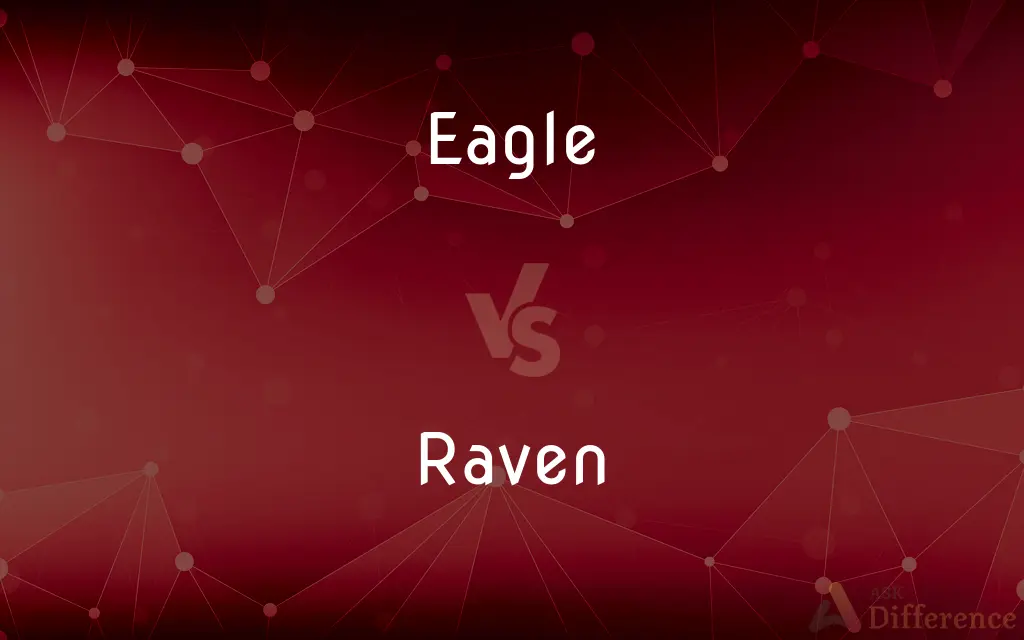Eagle vs. Raven — What's the Difference?
By Tayyaba Rehman & Urooj Arif — Updated on April 27, 2024
Eagles are large birds of prey known for their power and keen eyesight, often symbolizing freedom; ravens are smaller, highly intelligent corvids, noted for their adaptability and complex social behaviors.

Difference Between Eagle and Raven
Table of Contents
ADVERTISEMENT
Key Differences
Eagles are massive in comparison to most birds, with broad wings and strong bodies suited for hunting and soaring at high altitudes. In contrast, ravens, while still relatively large for birds, are more recognized for their problem-solving abilities and smaller, more agile bodies.
The diet of an eagle primarily consists of fish and small mammals, reflecting their role as apex predators in their environments. On the other hand, ravens are omnivores with a highly varied diet, including insects, fruits, seeds, and waste, showcasing their adaptability to diverse habitats.
Eagles are often solitary except during breeding season or when abundant food sources are available. Conversely, ravens are known for their complex social structures, engaging in playful behaviors, teamwork, and communication within their groups.
In terms of symbolism, eagles are frequently depicted as national emblems and icons of majestic and noble characteristics, especially in the United States and other countries. Ravens, while sometimes associated with ominous qualities, are also symbols of intelligence and cunning in various cultures.
The nesting habits of eagles typically involve high places like cliffs or tall trees, reflecting their need for security and a broad view of their territory. Ravens, however, are more versatile, nesting in a variety of locations from trees to rock ledges to buildings, adapting easily to both wild and urban environments.
ADVERTISEMENT
Comparison Chart
Size and Build
Larger, broader wings, heavy build
Smaller, more agile
Diet
Fish, small mammals (predatory)
Omnivorous, includes insects to waste
Social Behavior
Mostly solitary, some cooperative hunting
Highly social, complex communication
Symbolism
Freedom, power, nobility
Intelligence, adaptability, mystery
Nesting Habits
High places like cliffs and tall trees
Versatile, from trees to urban structures
Compare with Definitions
Eagle
A large bird of prey known for its powerful build and keen eyesight.
The eagle soared above the lake, scouting for fish.
Raven
Highly intelligent bird, part of the corvid family, known for problem-solving skills.
The raven figured out how to open the food container effortlessly.
Eagle
Symbolic of strength and freedom, often featured in national emblems.
The bald eagle is a prominent symbol on the U.S. national seal.
Raven
Often associated with mysticism and folklore, symbolizing wisdom or foreboding.
In folklore, the raven is often seen as a harbinger of change.
Eagle
Predatory habits, primarily hunting fish and small mammals.
The golden eagle swooped down to snatch a rabbit from the field.
Raven
Omnivorous diet, showcasing its adaptability to various environments.
The raven scavenged the park, eating anything from nuts to discarded snacks.
Eagle
Solitary outside of mating season, showcasing independence.
The solitary eagle perched atop the mountain peak, surveying its territory.
Raven
Engages in complex social interactions and playful behaviors.
A group of ravens played in the snow, rolling and sliding down slopes.
Eagle
Nests in high, secure locations to oversee its domain.
The eagle's nest was set high in the cliff face, away from predators.
Raven
Versatile in nesting, adapting from wilderness to urban settings.
The ravens nested on the building's ledge, unbothered by the city noise.
Eagle
Eagle is the common name for many large birds of prey of the family Accipitridae. Eagles belong to several groups of genera, some of which are closely related.
Raven
A raven is a large bird from one of several species of the genus Corvus. These species do not form a single taxonomic group within the genus.
Eagle
Any of various large diurnal birds of prey of the family Accipitridae, including members of the genera Aquila and Haliaeetus, characterized by broad wings, a hooked bill, keen vision, and soaring flight.
Raven
A large heavily built crow with mainly black plumage, feeding chiefly on carrion.
Eagle
A representation of an eagle used as an emblem or insignia.
Raven
(especially of hair) of a glossy black colour
Thick raven hair
Eagle
A gold coin formerly used in the United States, stamped with an eagle on the reverse side and having a face value of ten dollars.
Raven
(of a wild animal) hunt voraciously for prey
Fierce lions went ravening to and fro
Eagle
(Sports) A golf score of two strokes under par on a hole.
Raven
A large bird (Corvus corax) of the Northern Hemisphere, having black plumage and a croaking cry.
Eagle
To shoot (a hole in golf) in two strokes under par.
Raven
Any of several similar birds of the genus Corvus, found in Africa, Australia, and southwestern North America.
Eagle
To score an eagle in golf.
Raven
Variant of ravin.
Eagle
Any of several large carnivorous and carrion-eating birds in the family Accipitridae, having a powerful hooked bill and keen vision.
Raven
Voracity; rapaciousness.
Eagle
A gold coin with a face value of ten dollars, formerly used in the United States.
Raven
Something taken as prey.
Eagle
A 13th-century coin minted in Europe and circulated in England as a debased sterling silver penny, outlawed under Edward I of England.
Raven
The act or practice of preying.
Eagle
(golf) A score of two under par for a hole.
Raven
Black and shiny
Raven tresses.
Eagle
(golf) To score an eagle.
Raven
To consume greedily; devour.
Eagle
Any large, rapacious bird of the Falcon family, esp. of the genera Aquila and Haliæetus. The eagle is remarkable for strength, size, graceful figure, keenness of vision, and extraordinary flight. The most noted species are the golden eagle (Aquila chrysaëtus); the imperial eagle of Europe (Aquila mogilnik or Aquila imperialis); the American bald eagle (Haliæetus leucocephalus); the European sea eagle (Haliæetus albicilla); and the great harpy eagle (Thrasaetus harpyia). The figure of the eagle, as the king of birds, is commonly used as an heraldic emblem, and also for standards and emblematic devices. See Bald eagle, Harpy, and Golden eagle.
Raven
To seek or seize as prey or plunder.
Eagle
A gold coin of the United States, of the value of ten dollars.
Raven
To seek or seize prey or plunder.
Eagle
A northern constellation, containing Altair, a star of the first magnitude. See Aquila.
Raven
To eat ravenously.
Eagle
The figure of an eagle borne as an emblem on the standard of the ancient Romans, or so used upon the seal or standard of any people.
Though the Roman eagle shadow thee.
Raven
(countable) Any of several, generally large and lustrous black species of birds in the genus Corvus, especially the common raven, Corvus corax.
Eagle
Any of various large keen-sighted diurnal birds of prey noted for their broad wings and strong soaring flight
Raven
A jet-black colour.
Eagle
(golf) a score of two strokes under par on a hole
Raven
Rapine; rapacity.
Eagle
A former gold coin in the United States worth 10 dollars
Raven
Prey; plunder; food obtained by violence.
Eagle
An emblem representing power;
The Roman eagle
Raven
Of the color of the raven; jet-black
Raven curls
Raven darkness
She was a tall, sophisticated, raven-haired beauty.
Eagle
Shoot in two strokes under par
Raven
To obtain or seize by violence.
Raven
(transitive) To devour with great eagerness.
Raven
(transitive) To prey on with rapacity.
The raven is both a scavenger, who ravens a dead animal almost like a vulture, and a bird of prey, who commonly ravens to catch a rodent.
Raven
(intransitive) To show rapacity; to be greedy (for something).
Raven
A large black passerine bird (Corvus corax), similar to the crow, but larger, and has a harsh, loud call. It is native of the northern parts of Europe, Asia and America, and is noted for its sagacity.
Raven
Rapine; rapacity.
Raven
Prey; plunder; food obtained by violence.
Raven
Of the color of the raven; jet black; as, raven curls; raven darkness.
Raven
To obtain or seize by violence.
Raven
To devour with great eagerness.
Like rats that ravin down their proper bane.
Raven
To prey with rapacity; to be greedy; to show rapacity.
Benjamin shall raven as a wolf.
Raven
Large black bird with a straight bill and long wedge-shaped tail
Raven
Obtain or seize by violence
Raven
Prey on or hunt for;
These mammals predate certain eggs
Raven
Eat greedily;
He devoured three sandwiches
Raven
Feed greedily;
The lions ravened the bodies
Common Curiosities
Are eagles endangered?
Some eagle species are considered endangered or vulnerable due to habitat loss, hunting, and poisoning.
How do eagles hunt their prey?
Eagles use their keen eyesight and powerful flight to swoop down and capture prey with their strong talons.
What makes ravens particularly intelligent among birds?
Ravens display advanced problem-solving abilities, tool use, and complex social behavior, which are indicators of high intelligence.
How do ravens communicate with each other?
Ravens communicate through a variety of sounds and gestures, indicating different emotions and messages.
How long do eagles typically live?
Eagles can live up to 20-30 years in the wild, depending on the species.
How do ravens adapt to urban environments?
Ravens exploit food sources and nesting sites in urban areas, demonstrating their ability to adapt to various environments.
How do ravens affect other wildlife in their habitats?
Ravens can impact other wildlife by preying on eggs and young of other birds and small mammals, occasionally leading to conflicts.
Can ravens mimic sounds they hear?
Yes, ravens can mimic sounds from their environment, including human speech, which is part of their adaptability.
What are the social structures of ravens like?
Ravens form tight-knit groups that can cooperate in foraging and defense, and they engage in social play.
What threats do eagles face from human activity?
Eagles face threats from habitat destruction, collisions with vehicles, and poisoning from pesticides and rodenticides.
What role do eagles play in their ecosystems?
As apex predators, eagles help control populations of fish, birds, and small mammals, contributing to ecological balance.
What cultural significance do eagles hold in various societies?
Eagles are often revered as sacred animals or national symbols, representing power and independence in many cultures.
Where can you typically find eagles?
Eagles are found in a variety of habitats, from coastal regions and rivers to mountains and deserts, depending on the species.
Do ravens have a role in any ecological systems?
As omnivores, ravens help in seed dispersal, clean up carrion and waste, and can impact populations of smaller animals.
Can eagles be trained by humans?
Eagles have been used in falconry for centuries, showcasing their ability to be trained for hunting.
Share Your Discovery

Previous Comparison
Reliability vs. Robustness
Next Comparison
Assembly vs. MeetingAuthor Spotlight
Written by
Tayyaba RehmanTayyaba Rehman is a distinguished writer, currently serving as a primary contributor to askdifference.com. As a researcher in semantics and etymology, Tayyaba's passion for the complexity of languages and their distinctions has found a perfect home on the platform. Tayyaba delves into the intricacies of language, distinguishing between commonly confused words and phrases, thereby providing clarity for readers worldwide.
Co-written by
Urooj ArifUrooj is a skilled content writer at Ask Difference, known for her exceptional ability to simplify complex topics into engaging and informative content. With a passion for research and a flair for clear, concise writing, she consistently delivers articles that resonate with our diverse audience.
















































